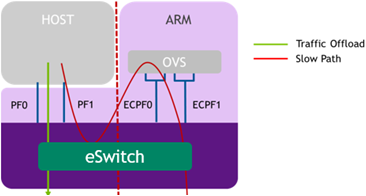Modes of Operation
The NVIDIA® BlueField® DPU has several modes of operation:
DPU mode or embedded function (ECPF) ownership where the embedded Arm system controls the NIC resources and data path (default)
Restricted mode which is an extension of the ECPF ownership with additional restrictions on the host side
NIC mode where the DPU behaves exactly like an adapter card from the perspective of the external host
This mode, known also as Embedded CPU Function Ownership (ECPF) mode, is the default mode for BlueField DPU.
In DPU mode, the NIC resources and functionality are owned and controlled by the embedded Arm subsystem. All network communication to the host flows through a virtual switch control plane hosted on the Arm cores, and only then proceeds to the host. While working in this mode, the DPU is the trusted function managed by the data center and host administrator—to load network drivers, reset an interface, bring an interface up and down, update the firmware, and change the mode of operation on the DPU device.
A network function is still exposed to the host, but it has limited privileges. In particular:
The driver on the host side can only be loaded after the driver on the DPU has loaded and completed NIC configuration.
All ICM (Interface Configuration Memory) is allocated by the ECPF and resides in the DPU's memory.
The ECPF controls and configures the NIC embedded switch which means that traffic to and from the host (DPU) interface always lands on the Arm side.

When the server and DPU are initiated, the networking to the host is blocked until the virtual switch on the DPU is loaded. Once it is loaded, traffic to the host is allowed by default.
There are two ways to pass traffic to the host interface: Either using representors to forward traffic to the host (every packet to/from the host would be handled also by the network interface on the embedded Arm side), or push rules to the embedded switch which allows and offloads this traffic.
Restricted mode is a specialization of Embedded mode and implements an additional layer of security where the host system administrator is prevented from accessing the DPU from the host. Once Restricted mode is enabled, the data center administrator should control the DPU entirely through the Arm cores and/or BMC connection instead of through the host.
For security and isolation purposes, it is possible to restrict the host from performing operations that can compromise the DPU. The following operations can be restricted individually when changing the DPU host to Restricted mode:
Port ownership – the host cannot assign itself as port owner
Hardware counters – t he host does not have access to hardware counters
Tracer functionality is blocked
RShim interface is blocked
FW flash is restricted
To enable host restriction:
Start the MST service.
Set restricted mode. From the Arm side, run:
$ mlxprivhost -d /dev/mst/<device> r --disable_rshim --disable_tracer --disable_counter_rd --disable_port_owner
WarningP ower cycle is required if any --disable_* flags are used.
If RShim is disabled, power cycle is required.
To disable host restriction, set the mode to privileged. Run:
$ mlxprivhost -d /dev/mst/<device> p
The configuration takes effect immediately.
If you are reverting from rshim-disabled mode, system power cycle is required.
P ower cycle is required when reverting to privileged mode if host restriction has been applied using any --disable_* flags.
Prior to configuring NIC Mode, refer to known issue # 3048250.
When NIC mode is enabled, the drivers and services on the Arm are no longer functional.
In this mode, the DPU behaves exactly like an adapter card from the perspective of the external host. The ECPFs on the Arm side are not functional in this mode but the user is still able to access the Arm system and update mlxconfig options.
To enable DPU NIC mode:
Run the following from the x86 host side:
$ mst start $ mlxconfig -d /dev/mst/<device> s INTERNAL_CPU_MODEL=1 \ INTERNAL_CPU_PAGE_SUPPLIER=1 \ INTERNAL_CPU_ESWITCH_MANAGER=1 \ INTERNAL_CPU_IB_VPORT0=1 \ INTERNAL_CPU_OFFLOAD_ENGINE=1
WarningTo restrict RShim PF (optional), make sure to configure INTERNAL_CPU_RSHIM=1 as part of the mlxconfig command.
Power cycle the host
Multi-host is not supported when the DPU is operating in NIC mode.
To obtain firmware BINs for NVIDIA® BlueField®-2 devices, refer to the BlueField-2 firmware download page.
If RShim is disabled, then power cycle is mandatory.
To change from back from NIC mode to DPU (ECPF) mode:
Install and start the RShim driver on the host.
Disable NIC mode. Run:
$ mst start $ mlxconfig -d /dev/mst/<device> s INTERNAL_CPU_MODEL=1 \ INTERNAL_CPU_PAGE_SUPPLIER=0 \ INTERNAL_CPU_ESWITCH_MANAGER=0 \ INTERNAL_CPU_IB_VPORT0=0 \ INTERNAL_CPU_OFFLOAD_ENGINE=0 $ mlxfwreset -d /dev/mst/<device> r
WarningIf INTERNAL_CPU_RSHIM=1, then make sure to configure INTERNAL_CPU_RSHIM=0 as part of the mlxconfig command.
If RShim is enabled, then power cycle is mandatory.
The following are the supported MLNX_OFED versions for when the DPU is operating in NIC mode:
|
Distribution |
Version |
Kernel |
|
RHEL/CentOS 8.4 |
8.4 |
4.18.0-305 |
|
Ubuntu 20.04 |
20.04 |
5.4.0-26 |
|
Ubuntu 22.04 |
22.04 |
5.15 |
|
Debian |
10.8 |
4.19.0-14 |
|
RHEL/CentOS 7.6 |
7.6 |
3.10.0-957 |
|
RHEL/CentOS 8.0 |
8 |
4.18.0-80 |
|
RHEL/CentOS 8.2 |
8.2 |
4.18.0-193 |
|
Ubuntu 18.04 |
18.04 |
4.15.0-20 |
|
RHEL/CentOS 8.5 |
8.5 |
4.18.0-348 |
|
RHEL/CentOS 8.6 |
8.6 |
4.18.0-359 |